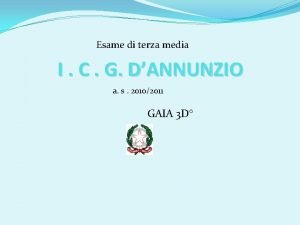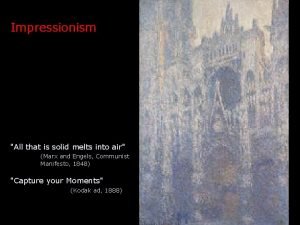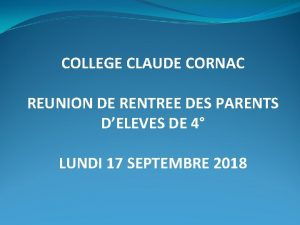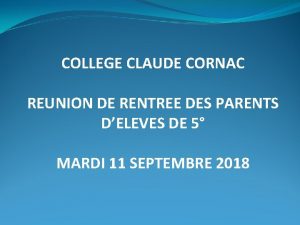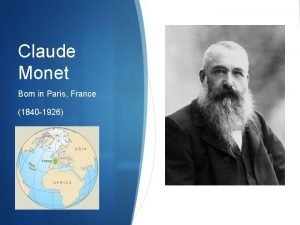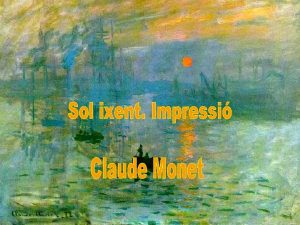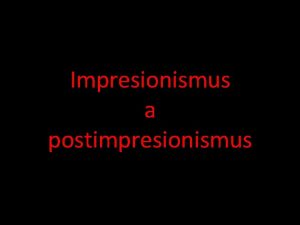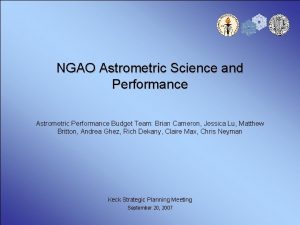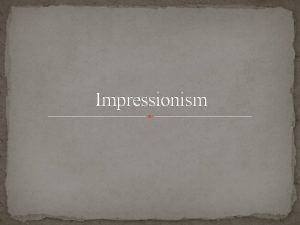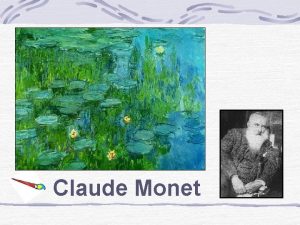The Astrometric Promise of Large A Dave Monet













- Slides: 13

The Astrometric Promise of Large A* Dave Monet U. S. Naval Observatory - Flagstaff Station September 21, 2008

Executive Summary

Is anything left to do? • Gaia and SIM promise to do everything: • • • Microarcsecond astrometry down to 20 th. Sub-microarcsecond astrometry for planets. Francois Mignard is a tough act to follow.

Ground vs. Space • Reasons to go to space: • • Ultimate in astrometric accuracy. Big teams of clever folks. Lots of money and glamour. Reasons to stay on the ground: • • Useful astrometric accuracy. Big apertures. High data rates. Long duration missions.

A* Astrometry • A* is etendue (meter 2 degree 2): • • • 4 projects are in construction or planning: • • • Pan-STARRS (U. Hawaii + USAF). Sky. Mapper (Australian National University). SST (DARPA + MIT/LL + USAF). LSST (LSST Corporation). Astrometric utility of any/all of these systems? • • Metric for telescope efficiency - sort of. New optical designs deliver large useful fields. New CCD mosaics offer many 108 to 109 pixels. Parallel electronics to read in a few seconds. Several visits to all available sky - per lunation! Astrometry for all 10**9 (or maybe 10**10) objects. No selection effect other than photons. Photography enabled motion - A* enables parallax.

Pan-STARRS - PS 1 • • • On Haleakala (Maui). First light: Aug 2007. ORR: Dec 2008. 3 survey: 15 visits in a total of 6 colors from =-30 to =+90. 1. 8 -m aperture. 1. 4 billion pixel camera. • PS-2, PS-4. •

Sky. Mapper • • • Siding Springs (Australia) First Light: Sep 2008? 6 visits in each of 6 colors from =-90 to =0. 1. 3 -m aperture. 256 million pixel camera.

LSST • • • Cerro Pachon (Chile). First Light: 2014? $50 M raised already. 3 visits of entire visible sky every lunation. 8. 4 -m aperture. 3. 4 billion pixel camera.

Astrometric Utility? Not much legacy for huge field, short exposure astrometry. • Data from Subaru, Gemini, SOAR, others. • My expectation: • • • 10 milliarcseconds per star per visit - differential. Limited by photons or seeing. Differential chromatic refraction is big issue. Solve sky chunk at a time - messy. Not sure about trying to solve for the sphere: • Why bother when Gaia will do this for us, much better. • • Faint - correction from relative to absolute is small. Real data starting to appear right now!


Summary • Astrometry at 10 Tbytes/night is fun! • Starting now! Expect milliarcsecond results before Gaia. • LSST will go much fainter than Gaia. • • • Astrometry at r = 26? Synergy between ground and space.

Kepler Astrometry - SNR ∞

 Dáma so slnečníkom monet
Dáma so slnečníkom monet Esame icg
Esame icg Impression sunrise claude monet 1872 oil on canvas
Impression sunrise claude monet 1872 oil on canvas Claude monet impresja wschód słońca
Claude monet impresja wschód słońca Claude monet 1840 1926
Claude monet 1840 1926 Monet falaise etretat
Monet falaise etretat A quel courant artistique appartient claude monet
A quel courant artistique appartient claude monet Camille monet on her deathbed
Camille monet on her deathbed Ent cornac
Ent cornac Claude cornac
Claude cornac Le monet cumbres
Le monet cumbres Edoard manet
Edoard manet Camp de roselles monet
Camp de roselles monet Manet obrazy
Manet obrazy

